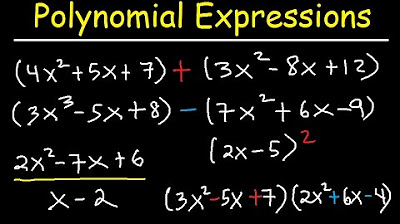Synthetic Division of Polynomials
Summary
TLDRThis educational video tutorial teaches viewers how to use synthetic division to divide polynomial functions. It guides through step-by-step examples, starting with dividing \(x^3 - 2x^2 - 5x + 6\) by \(x - 3\), and progresses to more complex polynomials. Each example illustrates the process of setting up coefficients, performing the division, and interpreting the remainder to determine if the polynomial is factorable. The video also highlights common mistakes, such as forgetting to include zero coefficients, and emphasizes the importance of order in polynomial functions. By the end, viewers should have a clear understanding of synthetic division and its application in polynomial division.
Takeaways
- 📚 Synthetic division is a method used to divide polynomial functions.
- 🔢 Start by writing down the coefficients of the dividend polynomial in descending order.
- 🎯 Identify the zero of the divisor (x - c) by setting it equal to zero and solving for x.
- ✏️ Place the zero found (c) at the top of the division process and bring down the first coefficient.
- 🔄 Perform the synthetic division steps: multiply, add, bring down, repeat until the end.
- 🧮 If the remainder is zero, the divisor is a factor of the polynomial; if not, it's not a factor but division still occurs.
- 📉 The quotient from the division is the resulting polynomial after the division process.
- 🔄 For non-zero remainders, include the remainder divided by the divisor as part of the final quotient.
- ⚠️ Remember to include all coefficients, including zero coefficients, when setting up the division.
- 📈 Practice with various examples to understand how synthetic division works with different polynomials and divisors.
Q & A
What is the main focus of the video?
-The main focus of the video is to teach how to divide polynomial functions using synthetic division.
What is the first polynomial function given in the video example?
-The first polynomial function given in the video example is x^3 - 2x^2 - 5x + 6.
By what factor is the first polynomial function divided in the video?
-The first polynomial function is divided by x - 3.
What does the number 3 represent in the synthetic division process for the first example?
-The number 3 represents the value of x that makes the divisor x - 3 equal to zero, which is one of the zeros of the function.
What is the result of the synthetic division for the first example?
-The result of the synthetic division for the first example is x^2 + x - 2.
What does a remainder of zero in synthetic division indicate?
-A remainder of zero in synthetic division indicates that the divisor is a factor of the polynomial, meaning the polynomial is factorable by the divisor.
What is the second polynomial function discussed in the video?
-The second polynomial function discussed is x^3 + 5x^2 + 7x + 2.
What is the divisor used for the second polynomial function in the video?
-The divisor used for the second polynomial function is x + 2.
What is the result of the synthetic division for the second example?
-The result of the synthetic division for the second example is x^2 + 3x + 1.
How is the remainder handled in synthetic division if it's not zero?
-If the remainder is not zero, it is added to the result as a fraction with the divisor in the denominator.
What is the importance of writing the polynomial function in descending order when performing synthetic division?
-Writing the polynomial function in descending order ensures that the correct coefficients are used in the synthetic division process, which is crucial for obtaining the correct result.
What is the final step in the synthetic division process after obtaining the quotient?
-The final step in the synthetic division process after obtaining the quotient is to add the remainder (if not zero) as a fraction with the divisor in the denominator to complete the division.
Outlines

This section is available to paid users only. Please upgrade to access this part.
Upgrade NowMindmap

This section is available to paid users only. Please upgrade to access this part.
Upgrade NowKeywords

This section is available to paid users only. Please upgrade to access this part.
Upgrade NowHighlights

This section is available to paid users only. Please upgrade to access this part.
Upgrade NowTranscripts

This section is available to paid users only. Please upgrade to access this part.
Upgrade NowBrowse More Related Video

X- AND Y- INTERCEPTS OF GRAPHS OF POLYNOMIAL FUNCTION|| GRADE 10 MATHEMATICS Q2

How to Divide Polynomials Using LONG DIVISION | Math 10

Polynomials - Adding, Subtracting, Multiplying and Dividing Algebraic Expressions

Lesson 33 Long Division to Find Roots

Solving Polynomial Equations By Factoring and Using Synthetic Division

Factor Theorem |G10 Q1 W6
5.0 / 5 (0 votes)